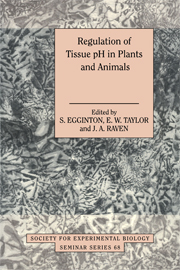Book contents
- Frontmatter
- Contents
- List of contributors
- Preface
- Measurement of intracellular pH: a comparison between ion-sensitive microelectrodes and fluorescent dyes
- pH-sensitive microelectrodes: how to use them in plant cells
- The use of nuclear magnetic resonance for examining pH in living systems
- Invasive studies of intracellular acid–base parameters: quantitative analyses during environmental and functional stress
- Lactate, H+ and ammonia transport and distribution in rainbow trout white muscle after exhaustive exercise
- Limiting factors for acid–base regulation in fish: branchial transfer capacity versus diffusive loss of acid–base relevant ions
- H+-mediated control of ion channels in guard cells of higher plants
- pH regulation of plants with CO2-concentrating mechanisms
- Intracellular pH regulation in plants under anoxia
- The role of turtle shell in acid–base buffering
- Acid–base regulation in crustaceans: the role of bicarbonate ions
- A novel role for the gut of seawater teleosts in acid–base balance
- pH and smooth muscle: regulation and functional effects
- Regulation of pH in vertebrate red blood cells
- Acid–base regulation in hibernation and aestivation
- Hepatic metabolism and pH in starvation and refeeding
- Back to basics: a plea for a fundamental reappraisal of the representation of acidity and basicity in biological solutions
- Index
pH-sensitive microelectrodes: how to use them in plant cells
Published online by Cambridge University Press: 22 August 2009
- Frontmatter
- Contents
- List of contributors
- Preface
- Measurement of intracellular pH: a comparison between ion-sensitive microelectrodes and fluorescent dyes
- pH-sensitive microelectrodes: how to use them in plant cells
- The use of nuclear magnetic resonance for examining pH in living systems
- Invasive studies of intracellular acid–base parameters: quantitative analyses during environmental and functional stress
- Lactate, H+ and ammonia transport and distribution in rainbow trout white muscle after exhaustive exercise
- Limiting factors for acid–base regulation in fish: branchial transfer capacity versus diffusive loss of acid–base relevant ions
- H+-mediated control of ion channels in guard cells of higher plants
- pH regulation of plants with CO2-concentrating mechanisms
- Intracellular pH regulation in plants under anoxia
- The role of turtle shell in acid–base buffering
- Acid–base regulation in crustaceans: the role of bicarbonate ions
- A novel role for the gut of seawater teleosts in acid–base balance
- pH and smooth muscle: regulation and functional effects
- Regulation of pH in vertebrate red blood cells
- Acid–base regulation in hibernation and aestivation
- Hepatic metabolism and pH in starvation and refeeding
- Back to basics: a plea for a fundamental reappraisal of the representation of acidity and basicity in biological solutions
- Index
Summary
Introduction
pH-sensitive microelectrodes of various designs have been used in plant physiology for over two decades. Davis (1976), using an antimony electrode, presented cytosolic and vacuolar data following light/dark changes in Phaeoceros laevis, and Bowling (1976), using the same electrode type, reported vacuolar pH profiles across the root cortex of Helianthus annuus. Due to some fundamental problems with this electrode, it did not prove very successful and is not in use nowadays. The recessed-tip Thomas-type glass–glass electrode proved to be a far more reliable tool. Using this electrode, Sanders and Slayman (1982) carried out an important study on pH regulation in Neurospora crassa, in which they demonstrated the predominant role of oxidative phosphorylation for cytosolic pH control. Unfortunately, however, the manufacture of this electrode is difficult and it has subsequently been rarely used in plant physiology.
In contrast, neutral carrier-based liquid membrane electrodes (Ammann, 1986) have gained wider acceptance and they have been used successfully for various problems of cell physiology. Although in principle these electrodes can be used to measure the free concentrations of a whole variety of ions, the number of laboratories that use this technique has remained comparatively small. The main reason for this may be that intracellular applications are technically difficult, requiring some electrophysiological background, training and patience (Felle, 1992).
This chapter outlines some principles of fabrication and possible applications of the pH microelectrode in order to clarify the technique for those who have little or no experience with it but who may want to measure pH (or free concentrations of other ions) in plant cells.
- Type
- Chapter
- Information
- Regulation of Tissue pH in Plants and AnimalsA Reappraisal of Current Techniques, pp. 19 - 44Publisher: Cambridge University PressPrint publication year: 1999



